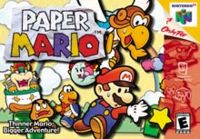Difference between revisions of "Paper Mario"
| Line 30: | Line 30: | ||
==Sequels== | ==Sequels== | ||
| − | Paper Mario was followed up by ''[[Paper Mario: The Thousand-Year Door]]'' in 2004. This game in many respects played upon the same formula of the first game. | + | Paper Mario was followed up by ''[[Paper Mario: The Thousand-Year Door]]'' for the [[Nintendo Gamecube]] in 2004. This game in many respects played upon the same formula of the first game. The following game, ''[[Super Paper Mario]]'', radically changed the gameplay to reflect Mario's platforming roots, but ''[[Paper Mario: Sticker Star]]'' has since moved back into the series's original gameplay style. |
==Rereleases== | ==Rereleases== | ||
Revision as of 10:42, 13 June 2017

| |
| Paper Mario | |
| Developer | Intelligent Systems |
| Publisher | Nintendo |
| System | Nintendo 64 Virtual Console |
| Release Date | Nintendo 64 JP August 11, 2000 US February 4, 2001 EU October 5, 2001 Virtual Console JP July 10, 2007 EU/AU July 13, 2007 US July 16, 2007 |
| Gallery | GH Gallery |
| Rating | ESRB: E |
Originally planned to be Super Mario RPG 2, the sequel to Mario's first RPG experience, Paper Mario (or Mario Story in Japan) became something new when Intelligent Systems took on the task of designing the game.
Story
The story involves Bowser stealing the all-powerful Star Rod from Star Haven and, as a first, seeking out Mario and using its powers to defeat him. Mario's only hope of taking back the Star Rod and saving the princess is to venture around the Mushroom Kingdom and save the seven Star Spirits. The game is divided into eight chapters and a Prologue, each ending after Mario has saved one of the Star Spirits. Between chapters, the player was given the opportunity to play as Peach and explore her baddie-infested castle, trying to find clues that she could send to Mario.
Gameplay
The most notable point of the game is the graphics; Paper Mario holds up to its name by featuring 2-D characters, much as you would see them in sidescrollers, exploring a colorful 3-D world. Second most notable is that only Mario and one of his eight party members can be used at a time, instead of three to five characters at once. Furthermore, only Mario had HP, while his partner could (on rare occasion) be merely stunned by damage. These aspects were often taken as turn-offs by gamers, rather than unique changes...
Paper Mario is not a particularly difficult game, with simplified puzzles and battle statistics that never exceed 99 points. The only controllable equipment in the game are badges, which replace the accessories in most RPGs. Unlike most, the number of badges that can be equipped is based on the number of Badge Points Mario currently has.
Legacy
While Paper Mario does not share much with its predecessor, Super Mario RPG, it did retain the action commands (timed hits) and expand upon them, giving almost every ability a unique command.
Sequels
Paper Mario was followed up by Paper Mario: The Thousand-Year Door for the Nintendo Gamecube in 2004. This game in many respects played upon the same formula of the first game. The following game, Super Paper Mario, radically changed the gameplay to reflect Mario's platforming roots, but Paper Mario: Sticker Star has since moved back into the series's original gameplay style.
Rereleases
- At one point it was announced for a rerelease on the Gamecube, but it was presumably can celled in favor of Paper Mario: The Thousand-Year Door.
- In 2007 it was released for download over the Virtual Console.